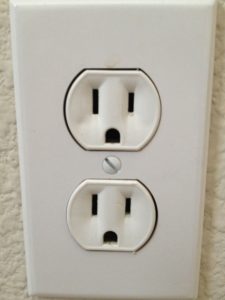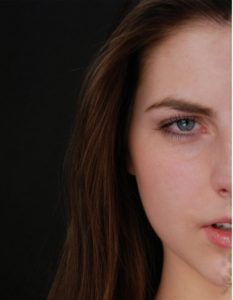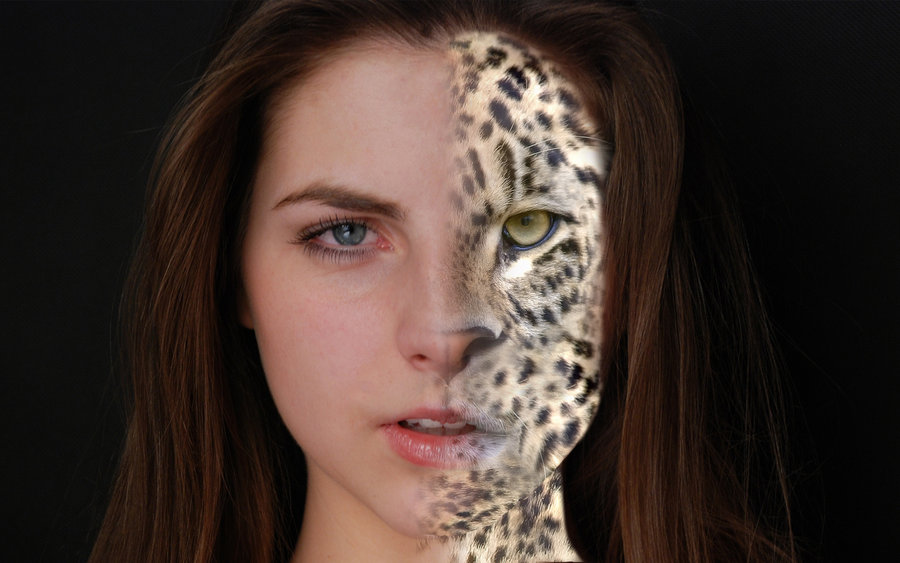The human brain is a pattern-seeking and pattern-making machine. In other words, we naturally look for patterns in the world around us, and will even make patterns out of things that may or may not have an actual pattern to them. In his book Understanding Comics, author Scott McCloud uses the North American design of a power socket as an example of this phenomena.

Looking at this image, you couldn’t be blamed for seeing two eyes and a mouth- a human face. We’re built to look for human faces in everything around us, and anything that even vaguely looks like a face will become one in human eyes. We look for faces, and even make them in places where they don’t actually exist. (Although you could argue that since a human designed this electrical socket, it was unconsciously designed to look like a face from the start. This isn’t the only design for a power socket you’ll find around the world, after all. Here’s a French one.)

And when human brains find a pattern, we don’t just link that pattern together randomly, we use patterns we already know to “fill in the gaps”. This is why a power socket can become a human face, or why if you’re shown half a picture of something you’ll naturally assume that the other half of that thing mirrors the half you were shown.

Even though that may or may not be true!
This effect is very useful in the arts, and especially film. In fact, it’s the very basis of film storytelling! Russian filmmaker Lev Kuleshov proved in early 20th century that if you showed an audience two images or pieces of film side by side, the audience would naturally assume and create a connection between those things, even if in reality they had nothing to do with one another. A phenomena which became known at the Kulashov Effect.
So, what does all of this have to do with storytelling?
A lot. In fact, it may be how all storytelling works.
In a story, we don’t tell every single thing that happens. Instead we select a series of events and string them together to form what we call a story. But, how does the audience know the connection between those events? Like the pieces of Kulashov’s film, it’s because we’ve given the audience pieces of information, and structured them in such a way that the audience interprets connections between those pieces of information.
If we’ve structure them well, then the audience will piece it together as we want them so- and ta-dah! We have a story!
If we don’t structure them well, then the pieces won’t fit together properly in the audience’s heads, and instead of a story we’ll end up with a jumbled mess that leaves the audience confused, or even worse- bored!
So, storytelling is all about creating connections between what happens in such a way that the brains of the audience will see it as a single clear narrative and get what the writer wants them to get from the story. And the skill of storytelling is the ability to lead your audience through those events in a way which gives them meaning and makes them appear like there’s only one natural way to see the story.
Think of being a storyteller as being like a Wilderness Guide. A forest is a big piece of land with many trees, rocks, streams and other features and you could go through it in many ways, but a wilderness guide takes visitors to the forest through it in a way which makes them think they’ve seen everything important while only having seen a small fraction of what’s actually there. And, in the same way as telling a story, different wilderness guides can give visitors different perspectives of what is otherwise still the same forest by taking them on different routes and paths over the same ground.
By controlling what the audience sees, and the way it sees it, a storyteller shapes and creates what we call a story. This is why it’s so important that a writer have a clear idea of what they’re trying to accomplish in their story before they tell it, and why it’s important to know the different ways a writer can stitch together a story from events.
The main way a writer does this is through creating what is called a Throughline, which is something that links all the elements of the story together in a way which makes the audience of that story see or feel the connections. To continue our Wilderness Guide metaphor, a throughline is a path (or paths, since most stories have multiple throughlines) which the writer has made through the story elements for the audience to follow.
Let’s look at some of the different kinds of throughlines which Storytellers use to link together events into a larger narrative. While all throughlines can be used to shape and link events, some provide stronger connections than others, so I’ve categorized them in terms of Strong Throughlines (those which easy shape a story) and Weak Throughlines (those which connect ideas, but don’t necessarily form a narrative on their own).
Strong Throughlines
Event Throughline
Since stories are all about cause and effect, it just makes sense that the easiest way to create a Throughline is by basing it around naturally linked or interconnected events. These should be a series of events which the audience is familiar with in some way, and which give the story structure by their “natural” patterns. By seeing the pattern in the events, it creates a connection between those events that turns a bunch of separate events into a narrative.
A simple example of this is a Romance story- humans have romantic relationships, and those relationships have different stages they go through. The audience knows those stages because they’ve lived them (or seen them happen with others) and so the Event Throughline of a Romance story gives it a natural structure. (Girl meets boy > they get to know each other > they fall in love > they become a couple > etc > etc)
If a writer has a male and female character meet, then they have them start to get to know each other, and continue to follow the Romance pattern in each scene (or series of story events) then the audience both knows what will happen and sees this throughline of the story clearly.
And this doesn’t just apply to natural human behavior, but any commonly linked series of events which occurs in our lives or media. For example, Procedures like baking a cake, or forming a club, or solving a murder can all be used to give a series of events a clear throughline which the audience will see as a story.
These Event Throughlines form the basis for most Genre Fiction, and the audience knows and loves watching or reading about them again and again because of their familiarity. Of course, this is also the danger of an Event Throughline- because the audience DOES know the events and how they run, the storyteller needs to find other ways to bring something to entertain the audience to the story while the events are playing out in their usual (or semi-usual) order.
Moral Throughline
A Moral Throughline is sometimes called a story’s Moral Argument, and is a set of ideas that the storyteller is trying to get the audience of the story to believe. In a Moral Throughline, everything in the story represents part of an argument supporting a particular way of seeing the world or acting in the world as a human being. The truth is, the vast majority of stories contain a Moral Argument just by the way the characters act and the events unfold- if good triumphs over evil, for example, that’s a Moral Argument against evil.
This kind of Throughline goes back to Morality Plays, but can also be found in everything from legends and folk tales to modern movies. In fact, some writing teachers like John Truby would claim that ALL stories are a form of moral argument playing out in front of the audience in everything from the characters, to the setting, to the events, to the symbolism which fills the story. This may or may not be correct (argue away!), but what is true is that Moral Throughlines can be a strong way to take a series of events and turn them into a clear and strong narrative.
Like Event Throughlines, Moral Throughlines also have the advantage of being able to follow a clearly defined structure that the audience already knows- the argument structure. The argument structure is one where you make a claim (state something is true), support it with evidence, and then use that evidence to make the audience believe your answer is the correct one. In the case of most stories, this is almost all done by example, not by the character actually saying the moral argument or pointing out the different steps.
In a simple Morality Play, for instance, the Hero (main character) will do good things, and the Villain (Active Opponent) will do bad things. The Villain will then meet a bad end because of their bad actions, while the Hero will be rewarded for their own good acts. The Moral Argument of the story then, is that you should be a “good” person because if you don’t, then bad things will happen to you.
However, don’t think that Moral Throughlines are limited to just simple Good vs. Evil stories, they can be arguments for or against any type of human behavior or ways to look at the world. This can be sociopolitical views of things like Capitalism (The Fountainhead by Ayn Rand) and Communism (Animal Farm by George Orwell), attitudes towards success like David Copperfield and Harry Potter, or just plain views of the nature of human existence like in Moby Dick or The Heart of Darkness.
One note- there are two kinds of arguments- Open Arguments and Closed Arguments. In a Closed Argument the arguer is aiming for a specific target when making the argument (Don’t do drugs. Slavery is bad. Hard work pays off.) and wants the audience to believe that specific point is true by the end of the argument. Whereas, in an Open Argument the arguer has a general point they’re arguing (No man is an island. With great power comes great responsibility. Life is about helping others. etc), and then everything that follows is evidence to support that general point. There may or may not be a specific conclusion in an Open Argument because it was never really heading for one, and just trying to convince the reader of a larger truth or way of seeing the world.
I mention this because Closed Arguments create stronger Throughlines and are much easier to structure a clear story around. They have a natural starting and ending point built into them, and that’s why they get used for most films and modern media stories. The main character will start as someone who either believes or is neutral to the argument’s point, and then through a series of events ends up believing in whatever the point of the writer is (or being an example of the point). This is a Closed Argument structure, as opposed to an Open Argument where the audience is generally left to take their own lesson from the story, and which doesn’t sit as well with most audiences. (We like to see the good guys win, and the lesson clearly laid out so we have a sense that all is right with the world.)
Character Throughline
In a Character Throughline, the story is usually structured around a character’s change from one point to another point. Usually, this is rooted in the character having a human need which they need filled, or something that needs to change in their life, and the Throughline becomes the events from the beginning of that change until the end of that time of change for the character. So, for example, a character going from being shy and nervous to outgoing and confident could be a Character Throughline because we’re watching the events unfold in a way which shows the progression of the character from being like A to being like B.
Of course, this Throughline doesn’t have to be emotional, or even positive. We could be watching a person age, grow old, and die, or go through the cycle of cancer treatments. The Throughline here is that the character is present during the events and changing in some way, and as long as there’s those two elements, then it creates a Throughline for the audience to follow and gives the story unity.
Another type of Character Throughline would be a Relationship Throughline, where the key parts are two (or more) characters being present, and their relationship with each other is changing as the events play out, thus connecting the scenes in some way by the changes which happen in their relationship(s) as things progress.
Question Throughline
One of the reasons people keep reading stories is because they want to know the answer to questions like “What happens next?” and “Where does this all go?” Questions like these can also form a Throughline to a Story, because the events which are playing out are giving clues or answers to questions the reader has. As long as the events continue to unfold answers to questions (and maybe create news ones) then it creates a Question Throughline.
Sometimes you’ll hear this referred to as the story’s “Dramatic Questions”, which are the questions which drive the reader to stay involved in the story, and good Question Throughlines can give a story a lot of power and focus. A few other common Question Throughlines are:
- How will they solve the problem?
- Will X survive until the end?
- Will X and Y get together in the end?
- Who is the real villain?
- Why is all this happening?
- Will X make their deadline?
- Why is X doing this?
- Who is Y really?
- When will X figure out what’s really going on?
- And so on…
Most storytellers set up a Question Throughline at the beginning of the story, and then spend the rest of the story answering them, with the story ending when the main Question Throughlines have been answered. One key here is having more than one Question Throughline, and then slowly answering them as the story unfolds in a way which keeps the reader satisfied that they’re getting closer to the answers while still not getting the main question answered until the end. It takes skill, but can make the story much more engaging.
Weak Throughlines
Thematic Throughline
Sometimes stories are created by having events be linked together by a clear Theme or Idea. In a story with a Thematic Throughline, that theme or idea will be present in most of the scenes and events of the story and will give the story events their connection. Thematic Throughlines are similar to Open Arguments, except that there may or may not be a conclusion that the writer wants the audience to reach through the story events. For example, everything that the characters are doing or experiencing might be connected to the theme of Racism in different ways. In a story purely about the theme of racism, we might see how racism affects different lives in different ways, while in one which is an argument about racism we’d see how each person’s life is negatively effected by racism. (Because the writer is making an argument about racism being bad as opposed to just exploring the topic in a general way.)
Symbolic Throughline
In this kind of Throughline, there are certain symbols which repeat in the different scenes and events, and through their repeating they link the different events of the story to each other. This can be visually, like in the use of certain colours, shapes or images, textually, like in the use of certain words or phrases, or even character traits or behaviors which pop up again and again.
As you might notice, Symbolic Throughlines are most often running through the presentation of the story, not the story itself. Character actions, choices, or behaviors can be symbols, but a symbol is something that represents something else in the minds of the audience, so we most often see these kinds of Throughlines used in the way the story is told as opposed to events. For example, the characters might all be named after makers of handguns, or the seven heavenly virtues. This is a layer of ideas which are outside the story, but which the audience still understands and they make the audience think in certain ways.
Emotional Throughline
As I’ve already said several times, there are patterns in the way human beings act and think, and that includes the way we feel. An Emotional Throughline is one where the focus is a character (or characters) goes a sequence or pattern of emotions and the events are linked by that emotional pattern. One example would be the stages of grief, which is a natural emotional pattern/process that people go through after suffering the loss of someone or something important to them. A story could be structured around those stages, with each of the stages playing out in the way the characters act and behave during the events we see.
Another take on an Emotional throughline could be a single emotion (love, hate, jealousy, joy, etc) which a character or characters are experiencing in the different scenes and events of the story, and watching how that emotion’s presence or absence changes and affects those characters. For example, if a series of characters are made to feel joy, each could react to it in a different way, depending on the nature of the person and circumstances.
Chronological Throughline
Someone once said that we’re all time travellers, but we can only go one way at the same speed. In a Chronological Throughline the events of the story are linked by time. What separates it from an Event Throughline (which is also linked by time) however, is that this type of throughline doesn’t need to play out in a particular order or being about cause and effect events. One of the most famous examples of a Chronological Throughline is found in Chaucer’s Canterbury Tales, where we see the events of a single time period from multiple perspectives and points of view. All the stories are linked by covering the same period of time, but offer different perspectives on what happened during that time.
Another Chronological Throughline happens when you weave stories into historical events and create Period Pieces. The historical events are giving shape and form to the events of the story, and they lend it the structure and form it needs to form a single narrative. You can find examples of this in the movies Titanic and Apollo 13, or in TV shows like Downton Abbey or North and South.
A third, and very common, Chronological Throughline is structuring the events around a ceremony, ritual, or custom which follows as a particular structure. So, for example, the events during a graduation ceremony, an exam, or even a whole school year (ala Harry Potter) can give shape to a story by giving it a framework upon which to build a narrative.
Action Throughline
Stories are about people acting, and certain actions, when repeated, can create throughlines as well. With an Action Throughline, you could show different results of the same action taking place at multiple times and places, or even how one character keeps trying the same action and getting the same or different results. The presence of the actions create the throughline, and link what’s happening in the audience’s minds.
This can be as simple as baking a cake, or as complex as writing a symphony or climbing a mountain, the key here is that we’re viewing how different people are involved in doing the same action and that links the ideas presented in the scenes.
Geographic Throughline
Someone once said that the land shapes people, and it can definitely shape stories. In a Geographic Throughline, everything is connected by place. A simple Geographic Throughline would be everything happening at a single location, but it can be more than that. The different aspects of a place can be used to connect the events of a story in different ways. Different rooms of a house could represent different steps in a larger story, and journeying through a place from A to B will also create a natural throughline as the audience knows where the story starts and begins physically and narratively.
Object Throughline
An Object Throughline uses an object of some kind and its presence (or lack of presence) to connect the events or scenes of the story. This can be a weak connection like the anthology series Dead Man’s Gun, where the presence of the same gun in each story connects them all, or it can be a strong connection like the One Ring from The Lord of the Rings, an object which everyone desires and around which the whole plot spins. On the other hand, the need or desire for an object like a key could shape a story as well, with that object’s absence causing plot events to occur or linking the actions which play out.
One variant of the Object Throughline is the Food Throughline, where the characteristics, customs and culture surrounding a particular food item shape the story events. The Japanese anthology series Midnight Diner: Tokyo Stories is an example of this kind of throughline, where the different aspects of a dish shape the story in many ways. Of course, similar throughlines can be constructed around other types of objects besides food, but since food is so deeply rooted in our culture and has so many meanings, it allows for stronger connections than many other types of objects.
As you can see, Strong Throughlines are most often used to structure the story itself, while Weak Throughlines tend to be subplots or ideas that the writer wants to use to say certain things throughout the story. Weak Throughlines are also often used in Anthologies or collections of stories to link the stories in some way to create a greater story out of many smaller ones. For example, using a Geographic Throughline in Sunshine Sketches of a Little Town allows Stephen Leacock to turn a series of stories about life in the small town of Mariposa into a multifaceted view of life in rural Canada, or a TV series like Chicago Hope to give a multifaceted (if overly dramatic) view of working in a hospital.
On the other hand, mastering Event Throughlines is perhaps the most basic skill of writing a story, since cause and effect events are the simplest and strongest way to create what human beings call a story. By then layering other types of throughlines on top of the events playing out (Usually Moral and Character throughlines) we get a story with multiple levels that the audience can follow in different ways and get more satisfaction from. In fact, what is often referred to as a “deep” story is nothing more than a story with many throughlines running inside it which can be followed and enjoyed by the audience in different ways and generate different responses.


Nicely done! Essentially McKee goes into this, and the Story Toolkit talks about “Image Sets” which often connects to the thematic.